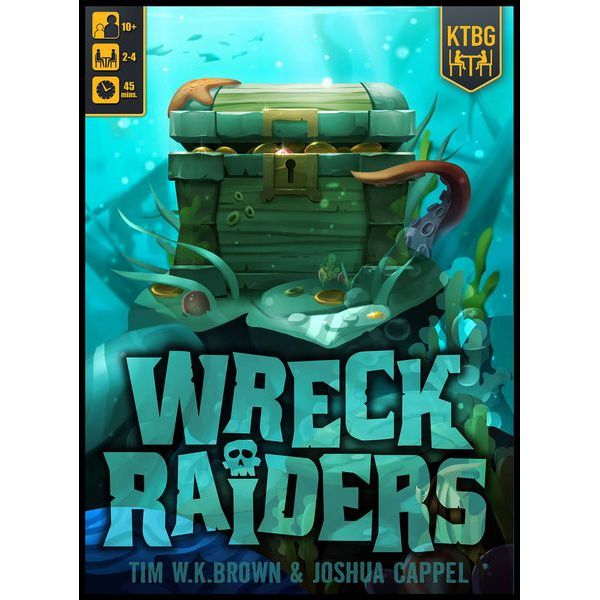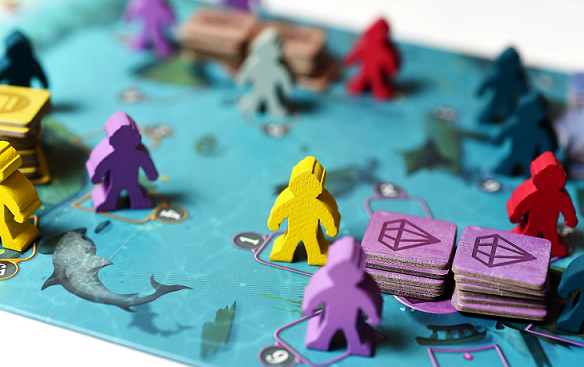Collect Lost Underwater Treasures in Wreck Raiders

Dive into the ocean to collect lost treasures. Fulfil orders for exhibits or stash your findings in your vault. Create aquariums full of diverse sea creatures, and gather shells from the beach.
The most complex game yet from KTBG (Kids Table Board Games), Wreck Raiders offers plenty to do, but how does it play for fans of casual games?
Gameplay
Each player receives a player board that has a display section (three rows of five squares) and a vault (four rows of three squares). Each player also takes a number of meeples. The board is set in the center of the table: it shows four shipwreck zones, each colored according to the four different colors of treasure tiles. Around each zone are six spaces, numbered one through six. There is also the beach area of the board, which is also numbered one through six, with each space depicting two shells. There are three different types of shells in the game.
Whenever there are no dice to claim, players roll all the dice into the box top. There are various squares in the box top that show the shells. At the start of your turn you will claim a die. If that die had also been rolled in such a way as to land at least partially on one of the shell squares, you get to take one of those shells.
On your turn, after you take a die, you then place one of your meeples (or move one from another location on the board) to any location on the board whose number matches the number on the die you took — but you can’t move one of your meeples from one spot in a zone to another spot in the same zone. If you go to a beach spot, you take the shells listed on that spot; if you move to a shipwreck spot you take a facedown treasure token of the appropriate color. However, when a meeple is placed on a wreck spot, the meeples on either side of it also award a treasure tile for the player or players that control them.
If you move a meeple onto a wreck spot that already has a meeple there, that meeple is moved to the beach (and the player that meeple belongs to gets the appropriate shells). If a meeple moves to an occupied beach spot, the meeple that was there is placed back in the owner’s hand. You can’t, however, move your meeple onto a location one of your own meeples already occupies.
When you gain a treasure tile, you flip it over, look at the treasure type, and then choose to either place it in your vault or in your display. When placing a treasure in your vault, you place it face up so that you see the treasure type. You may place a new treasure tile on any row of the vault, but treasures in the higher rows must have a treasure directly below them in the row down. At the end of the game you score points for each unique type of treasure in your vault, and for having filled rows with treasures that are all the same color.
Treasures added to your display are placed facedown, so that only the color is seen. During the game there are exhibit cards face up on the table. Each one shows a series of colored treasure tiles in a specific order. When you have the correct number and color of treasures in one of the rows in your display, you may discard the tiles to claim the matching exhibit card which will be worth points at the end of the game. Some cards will award you bonus shells or a bonus aquarium tile if you also manage to match the order of the treasure tiles. Also, some cards will be worth an extra two points if you spend a conch shell when claiming the card, or allow you to draw one treasure of any color if you spend a scallop shell when claiming it. After you are done claiming exhibit cards on your turn, new ones will be drawn to replace them.
You may also buy an aquarium piece on your turn. Aquariums always have a top piece, a bottom piece, and at least one middle piece, and you may work on multiple aquariums at one time. Each piece costs a different type and number of shells. They will score at the end of the game, earning a number of points written on them and also bonus points based on a formula written on the top piece of the aquarium (such as earning extra points for the number of times certain shells appear on the each piece or for the number of pieces in the completed aquarium).
Finally, players can discard shells for special abilities, such as spending a scallop before moving a meeple to a wreck spot in order to claim two treasures, or using a conch to subtract or add one to a die’s number.
The game ends once a certain number of exhibit cards have been claimed by one player, and the player with the most points wins the game.

Review
Wreck Raiders has a lot of elements that fit together nicely: set collection, dice selection, and worker placement. There is also great player interaction, with bumping meeples back to the beach and then off the board, competing over the same exhibit cards, and adjacent meeples earning treasure tiles.
There are plenty of strategic choices at each level of Wreck Raiders. Do you commit this treasure to your vault or your display? Which tiles do you purchase for your aquariums, and what combos can you create for the scoring formulas? Which treasure spot do you move to, keeping in mind that adjacent meeples will also earn treasure? Can you set it up so that you’ll be moving next to your own piece or will you try to position your diver to be adjacent to where an opponent might move?
Setup takes a little while, sorting all the tiles and putting them in the appropriate spots, and there are a substantial number of rules to teach. There are many small elements you have to cover, and while there is a lot of iconography to help new players remember everything it’s not always completely clear. So there will be a bit of time between getting the game on the table and when you can actually start playing.
Despite this, the game is fairly intuitive once everything has been taught, so there’s not a steep learning curve. Wreck Raiders has a lot of elements that are present in more complex games, but keeps things fairly simple and accessible, making it a good, slightly heftier game if you have groups with mixed tastes on game weight, or if you’re looking to try something a little more complex.
The artwork is lovely and nicely captures the underwater theme. The use of the box top for the dice rolling is a clever feature, and is also used when tallying up scores at the end. It would be nice to see more games using their boxes in similarly creative ways.
Wreck Raiders has lots of strategy and choices to make and plays at a nice pace that doesn’t drag on too long. It may be a bit more complex than your average casual game, but once learned is a fairly smooth experience, and the gameplay is well worth the extra time it takes to reach that point. It is a lovely blend of various mechanics, tied together with high-quality components.
Pros: Lots of player interaction, good quality components, nice blending of mechanics
Cons: Takes a while to set up and teach, not all the iconography is intuitive
Disclosure: we received a complimentary review copy of this game.







